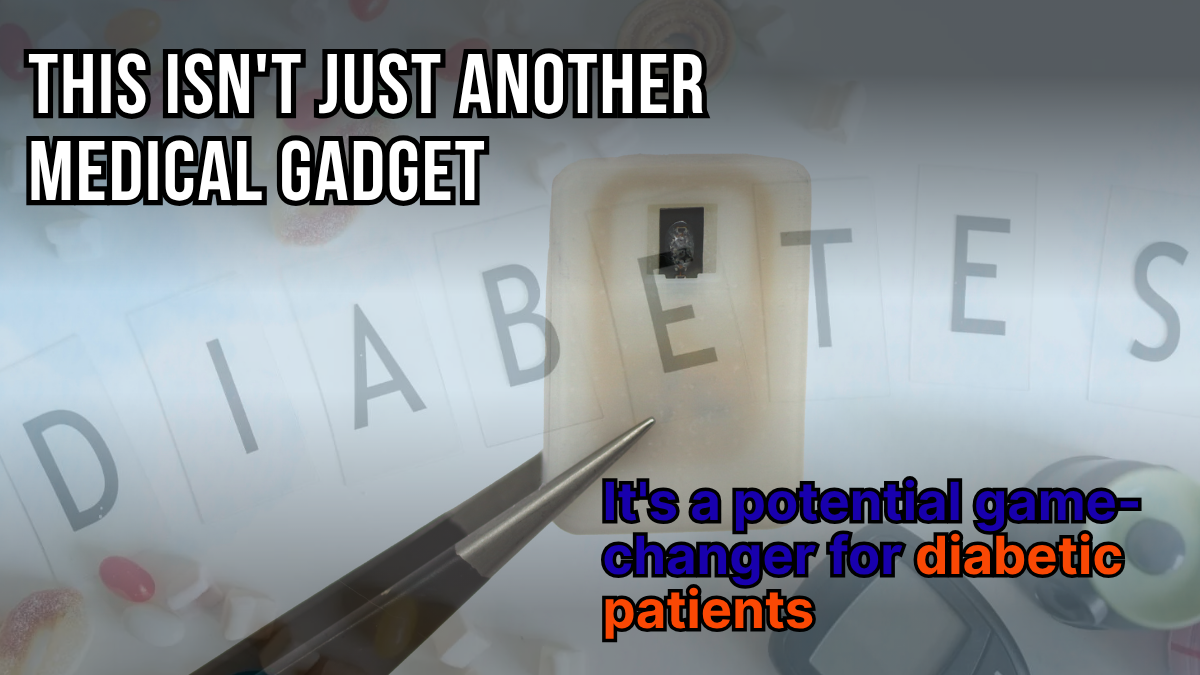For millions of people with Type 1 diabetes, the threat of hypoglycemia lurks constantly. One moment you’re going about your day, the next you could be facing a life-threatening drop in blood sugar that leaves you confused, unable to think clearly, or worse unconscious.
Now, researchers at MIT have developed a groundbreaking solution that could transform how we handle these medical emergencies. Their new implantable device acts like a silent guardian under the skin, ready to release life-saving medication when blood sugar levels plummet to dangerous levels.

This isn’t just another medical gadget, it’s a potential game-changer for diabetic patients who live in constant fear of hypoglycemic episodes, especially children and those who experience episodes during sleep.
The Hidden Dangers of Hypoglycemia
Type 1 diabetes affects over 1.6 million Americans, requiring constant vigilance to maintain healthy blood sugar levels. While most patients focus on preventing high blood sugar through insulin injections, the opposite problem hypoglycemia, poses equally serious risks.
When blood glucose drops too low, the brain doesn’t receive enough fuel to function properly. This can trigger confusion, seizures, loss of consciousness, and in severe cases, death. The standard treatment involves injecting glucagon, a hormone that signals the liver to release stored glucose into the bloodstream.
But here’s the challenge: recognizing hypoglycemia isn’t always straightforward. Some patients can sense the warning signs and take action, while others slip into dangerous territory without realizing it. This problem becomes even more concerning during sleep, when patients rely entirely on glucose monitor alarms to wake them.
“Some patients can sense when they’re getting low blood sugar, and go eat something or give themselves glucagon,” explains Daniel Anderson, the study’s senior author and professor at MIT’s Department of Chemical Engineering. “But some are unaware that they’re hypoglycemic, and they can just slip into confusion and coma.”
How the MIT Device Works
The new implantable device represents a remarkable feat of biomedical engineering. About the size of a quarter, it contains several sophisticated components working together to create an emergency response system.
At its core lies a small drug reservoir made from 3D-printed polymer materials. This reservoir stores a powdered form of glucagon, which remains stable much longer than liquid versions of the medication. The device can hold either one or four doses of the life-saving hormone.
The reservoir is sealed with a shape-memory alloy. A special nickel-titanium material that can be programmed to change shape when heated. In its normal state, this alloy forms a flat seal. But when heated to 40 degrees Celsius (104 degrees Fahrenheit), it curls into a U-shape, breaking the seal and releasing the stored medication.
The heating mechanism is triggered by a small electrical current, which is activated when the device receives a specific radiofrequency signal through its built-in antenna. This wireless activation system opens up multiple possibilities for triggering drug release.
Remote Activation and Automatic Response
One of the most innovative aspects of this device is its ability to communicate with other medical devices. The wireless receiver can be programmed to respond to signals from continuous glucose monitors the devices that many diabetic patients already use to track their blood sugar levels.
“One of the key features of this type of digital drug delivery system is that you can have it talk to sensors,” notes Siddharth Krishnan, the study’s lead author and former MIT researcher. “The continuous glucose-monitoring technology that a lot of patients use is something that would be easy for these types of devices to interface with.”
This means the device could automatically detect when blood sugar drops below safe levels and immediately release glucagon without any action required from the patient. For parents of diabetic children, this autonomous response capability could provide tremendous peace of mind.
Proven Results in Animal Testing
The MIT team tested their device in diabetic mice, with encouraging results. When researchers triggered glucagon release as the animals’ blood sugar levels were dropping, the medication began working within 10 minutes. Blood glucose levels stabilized and remained within normal ranges, successfully preventing hypoglycemia.
The device showed similar effectiveness when loaded with epinephrine, a medication used to treat heart attacks and severe allergic reactions. Within 10 minutes of drug release, epinephrine levels in the bloodstream increased significantly, and heart rate rose as expected.
One concern with any implanted device is the body’s natural response to foreign objects. Typically, scar tissue forms around implants, which can interfere with their function. However, the MIT researchers found that even after fibrotic tissue developed around their device, they could still successfully trigger drug release.
Long-Term Potential and Future Development
The research team kept devices implanted for up to four weeks during their initial studies, but they’re now working to extend that timeframe significantly. The goal is to create a device that could remain functional for at least a year, possibly longer.
“The idea is you would have enough doses that can provide this therapeutic rescue event over a significant period of time,” Krishnan explains. “We don’t know exactly what that is-maybe a year, maybe a few years, and we’re currently working on establishing what the optimal lifetime is. But then after that, it would need to be replaced.”
The researchers are planning additional animal studies and hope to begin human clinical trials within the next three years. If successful, this timeline could bring the device to market within the next decade.
Beyond Diabetes: Emergency Medicine Revolution
While the current focus is on diabetes management, the implications of this technology extend far beyond blood sugar control. The same wireless-activated, implantable system could potentially deliver other emergency medications for various conditions.
The successful testing with epinephrine demonstrates this versatility. Future applications might include devices that deliver medications for severe allergic reactions, heart conditions, or other medical emergencies where rapid drug delivery could save lives.
“It’s really exciting to see our team accomplish this, which I hope will someday help diabetic patients and could more broadly provide a new paradigm for delivering any emergency medicine,” says Robert Langer, the David H. Koch Institute Professor at MIT and study co-author.
What This Means for Diabetic Patients
For the millions of people living with Type 1 diabetes, this device represents more than just a medical breakthrough. It also offers hope for a life with less fear and more freedom.
Parents of diabetic children could sleep better knowing their child has 24/7 protection against hypoglycemic episodes. Adults with diabetes could feel more confident about activities like exercise, travel, or simply going about their daily routines without constantly worrying about blood sugar crashes.
The device could be particularly valuable for patients who experience hypoglycemia unawareness condition where the usual warning signs don’t occur, leaving patients vulnerable to sudden, severe drops in blood sugar.
The Road Ahead
While the MIT device shows tremendous promise, several hurdles remain before it reaches patients. The upcoming clinical trials will need to demonstrate not only that the device works safely in humans, but also that it can be manufactured cost-effectively and integrated seamlessly with existing diabetes management systems.
Questions about device longevity, replacement procedures, and potential complications will need thorough investigation. Regulatory approval processes will also require extensive documentation of safety and efficacy.
Despite these challenges, the research team remains optimistic about the device’s potential impact. The study, published in Nature Biomedical Engineering, represents years of careful development and testing, bringing us closer to a future where diabetic emergencies could become far less threatening.
A New Era of Emergency Medicine
The MIT implantable device represents a significant step forward in emergency medicine technology. By combining wireless communication, biocompatible materials, and smart drug delivery systems, researchers have created a device that could fundamentally change how we approach medical emergencies.
For diabetic patients and their families, this innovation offers something invaluable: the promise of a safety net that never sleeps, never forgets, and stands ready to act when life hangs in the balance. As clinical trials move forward, we may be witnessing the beginning of a new era in diabetes care and one where technology serves as a silent guardian, protecting patients from their condition’s most dangerous moments.
FAQs: Frequently Questions Asked
Q. What is the purpose of the implantable device?
A. The implantable device is designed to automatically release glucagon during hypoglycemic episodes, helping diabetic patients avoid dangerous drops in blood sugar levels.
Q. How does the device work?
A. The device monitors blood sugar levels and releases glucagon when it detects a hypoglycemic episode. This ensures that the patient’s glucose levels stabilize without the need for immediate external intervention.
Q. Is the device currently available for public use?
A. No, the device is still in the clinical trial phase. Researchers are conducting further studies to ensure its safety and effectiveness before it becomes widely available.
Q. Who can benefit from this device?
A. The device is aimed at individuals with diabetes who are at risk of severe hypoglycemia. It could particularly benefit those who experience frequent or unpredictable episodes of low blood sugar.
Q. Are there any potential risks associated with the implant?
A. While the device is still being tested, researchers are working to address any possible risks, such as infection or rejection, to ensure it is safe for long-term use.
Q. When will the device be accessible to the public?
A. There is no definitive timeline yet, as the device needs to pass regulatory approvals and further testing. However, its progress in clinical trials marks a promising step forward.
For More Information Click HERE




